Abstract
The article presents the findings of a study that evaluates the feasibility of using an analytical model for a multi-service queuing system with a SDFIFO queuing service discipline and finite compression mechanism to approximate queuing systems with different queuing service disciplines (e.g., FIFO, cFIFO) while also incorporating finite compression. The evaluation involves comparing results obtained from an analytical model with those of simulation studies. The study considers the blocking probability and average queue length as factors. Additionally, two types of compressed traffic were analysed: elastic and adaptive. These are characteristic of modern telecommunications networks, particularly in multimedia applications. This paper is an extended version of our paper published in 4th CoBCom 2022.
1. Introduction
The widespread accessibility of the Internet implies that the volume of traffic generated by users, particularly those using mobile devices, increases annually [1,2]. Data transmitted for multiple services must be sent over the network in accordance with their QoS requirements, posing a significant challenge for telecommunications networks. Thus, network operators employ various traffic management mechanisms to optimise their network resources. Commonly used mechanisms include resources reservation, finite and infinite compression, telecommunication traffic overflow, priorities, and queuing. These mechanisms can be used individually or in combination. It is important to note that the impact of traffic management mechanisms on network operation is determined by their proper parametrisation rather than the number of mechanisms employed. Analytical models offer the advantage of providing prompt results, enabling swift adjustments to the parameters of traffic management mechanisms. Prior studies contained several analytical models of systems incorporating different traffic management mechanisms. Typically, these models focus on a single mechanism. For instance, the authors of [3,4,5,6,7,8] present models of a systems with dynamic resource reservation, restricting the utilisation of the system resources via selected calls. Conversely, the models proposed in [9,10,11,12,13,14,15,16,17,18] address the problem of traffic compression, which has become increasingly prevalent as transmission speeds fluctuate based on network load. Another notable mechanism is telecommunications traffic overflow, one of the earliest traffic management mechanisms, which was developed in the 1950s. Recent models have facilitated the effective utilisation of this mechanism in modern networks [19]. Models focusing on systems with priorities represent the fewest among the groups of traffic management and control mechanisms [20]. The analysis of queuing systems is an extensive area of research, with most telecommunication system models being designed for single-service systems at the packet level [21,22]. However, the literature also includes publications on multi-service systems [17,19], enabling the determination of queuing system parameters such as blocking probability, average waiting time, and average queue length. Notably, among these multi-service models, proposals have been made for systems employing queuing and finite and infinitude compression.
In modern ICT networks, packets serve as the fundamental data units. Packets generated by web applications associated with various services from data streams are referred to as calls in the literature. Each type of call is linked to a constant bit rate (CBR) determined based on the maximum bit rates of actual variable bit rate (VBR) packet streams or equivalent bandwidth [23]. Numerous studies on traffic parametrisation in packet networks indicate that the choice of CBR evaluation method does not affect the analytical modelling process of such systems, and traffic at the call level can be described by Poisson streams [14]. Consequently, it is possible to analyse and model multi-service queuing systems based on a multidimensional Markov process. Therefore, in this article it is assumed that the equivalent bit rate values for individual classes demands are known. The determination of constant bit rate for calls offered to the system allows for their expression in a unit known as the allocation unit (AU). The Au is defined as the greatest common divisor of all CBRs of calls (flows) offered to the system. The process of expressing the system’s capacity and the demanded resources needed to serve the calls offered to the system is known as bandwidth discretisation [24]. This process facilitates determining the total values of the system capacity and the resources necessary to provide network services, enabling the analysis and modelling of such systems at the micro and macrostate levels [16,25]. Queuing systems are defined by their structural parameters (server capacity and queue capacity) and traffic parameters (number of calls offered to the system, traffic intensities, and average service time). The characteristic of the incoming traffic (e.g., the distribution of the call stream significantly impacts the system analysis [26,27]. In turn, queue system properties are usually assessed using parameters like loss probability, blocking probability, average queue length (representing the average queue number of occupied queue resources), and average waiting time for call servicing. The multi-service model of a queuing system proposed in [9] was developed for a specific queue discipline called Stat-Dependent First In First Out (SDFIFO). This discipline allows system analysis using the reversible Markov process. However, implementing the SDFIFO discipline in the real system is challenging. Therefore, this article aims to find a practical equivalent to SDFIFO discipline. The analytical model’s results are compared with digital simulation results of queuing systems employing the following queuing disciplines: First In First Out (FIFO), continuous FIFO (cFIFO), and virtual queues with FIFO and cFIFO disciplines. The remaining sections of the article are organised as follows: Section 2 presents an analytical model of a queuing system with adaptive and elastic traffic. Section 3 introduces queuing disciplines. Section 4 presents a selection of empirical results that exemplify the findings of the studies and a comprehensive discussion. In the conclusion, Section 5 provides a summary of the article.
2. Queuing Model of the System with Elastic and Adaptive Traffic
2.1. Elastic and Adaptive Traffic
The recent surge in network services that generate elastic and adaptive service streams has led to a heightened focus on developing analytical models that accurately reflect the quality of service (QoS) requirements for such systems. These models incorporate the concept of compression, which is triggered when a new call cannot be accommodated for service. The compression mechanism reduces the number of allocation units (AUs) required for the currently serviced calls and the incoming call, thus freeing up resources in the system and enabling the service of a new call. Depending on the nature of the service, the compression mechanism may also extend the call service time, such as in the case of a service that requires the transfer of all data in their entirety. Traffic for which the service time extends is referred to as elastic traffic in the literature, whereas traffic with a fixed service time is termed adaptive traffic. Notably, applications that rely on the transmission control protocol (TCP), such as WWW browsing, FTP file transfers, and electronic mail, generate elastic streams, while store-and-forward applications, such as streaming movies or music over the Internet, produce adaptive streams [17,28].
2.2. Analytical Model of the Multi-Rate System with Elastic and Adaptive Traffic
Let us consider a multi-service queuing system characterised by a capacity of AUs, a virtual capacity of AUs ( ), and a queue capacity of AUs. Let us assume that the elastic call classes and adaptive call classes are offered to the system. The virtual capacity accounts for the impact of the compression mechanism in the analytical model and determines the maximum compression rate of elastic and adaptive calls. This rate is calculated as the ratio of the actual system capacity to the virtual capacity, denoted as . Elastic and adaptive calls are subject to the compression mechanism only if the total number of AUs seized after receiving a new call exceeds the actual system capacity and simultaneously falls within the virtual capacity of the system. Otherwise, the new call will be directed to the buffer, and if there are insufficient resources, it will be rejected. When the compression mechanism is activated, it leads to a decrease in the required amount of resources based on the current compression factor. For elastic traffic classes, it also results in an extension of the service time, which is also dependent on the current value of the compression factor. While the servicing time for adaptive calls remains unaffected, the services associated with elastic traffic utilize the Transmission Control Protocol (TCP) [29], whereas those linked to elastic traffic are built upon the Real-Time Protocol/User Datagram Protocol (RTP/UDP) [30].
The article employs the following notations to represent traffic stream parameters:
- —The intensity of calls of class i type u, which follows an Erlang distribution;
- —The service intensity of class i type u, which follows an exponential distribution;
- —The number of AUs required for a connection of class i type u to be set up;
- —The intensity of offered traffic of class i type u:
where . In the paper it is assumed that the subscript e denotes the parameters of the elastic traffic classes, while the subscript a denotes the parameters of the adaptive traffic classes.
The diagram of a multi-service queuing system with finite compression mechanism is shown in Figure 1. In the analytical model, the compression mechanism is activated when the system capacity is exceeded, resulting in a reduction in requested resources and/or an increase in call service time. The characteristic parameters of the elastic and adaptive traffic classes vary based on the system’s state. This interpretation divides the system into three areas: the real area, in which the number of calls is less than or equal to the real system capacity (); the virtual area, in which the number of calls exceeds the real system capacity but is less than or equal to the virtual system capacity (); and the queue, where the number of calls exceeds the virtual system capacity but is less than or equal to the buffer capacity (). The nominal parameter values of traffic classes are used in the real area, while in the virtual area, they are adjusted to account for the compression mechanism. In the queue, the parameter values are determined based on the maximum compression coefficient. Table 1 shows the parameter values of traffic classes in the specified areas of the system’s occupancy.

Figure 1.
Diagram of a multi-service queuing system with finite compression mechanism.

Table 1.
Parameter values of traffic classes in the specified areas of the system’s occupancy.
It is worth emphasising that the compression ratio value in the queue area should not be interpreted as a measure of call compression within that area. Rather, this value indicates that calls in the queue are serviced from the buffer to the server using the maximum compression coefficient. The distribution of system occupancy in the multi-service queuing system under consideration, which incorporates finite compression, can be expressed using the following equation [9]:
where represents the probability of the occupancy of n AUs in the system for all , the value of results from the normalisation condition , parameters and for are described in the Table 1.
By analysing the local equilibrium equations, the authors of [9] proved that the mean number of serviced calls of class i of elastic type, within an occupancy state of n AUs (parameter ), can be determined using the following equation:
While the average number of serviced calls belonging to class i of adaptive type within an occupancy state of n AUs (parameter ) is expressed by the following formula, as shown in [9]:
2.3. Queuing Characteristics of the System
The average queue length is determined based on a methodology proposed by the authors, which involves an analysis of the bust states within the system. The method adopted for calculating the average length in the considered system is well established and allows for accurate determination of the average queue length using the following formula:
The system under consideration has a finite buffer, making it possible to determine the blocking probabilities for calls offered to the system. The blocking probability of class i of type u () occurs in states in which the system lacks sufficient resources to accept a call to the buffer. Therefore, we have:
where .
3. Queuing Disciplines
The analytical model of a multi-service queuing system presented in the Section 2 was proposed in the paper [9] and developed by the authors for “a queuing service discipline called SDFIFO”. This discipline assumes that the service of calls in the queue depends on the current state of the system precisely for all occupied AUs in the server and queue (this concept is analogous to the fairness mechanism used in the processor sharing problem [31]). Although the practical application of this queue service discipline is limited, the analytical model accurately approximates systems with a FIFO discipline to which multi-service elastic and adaptive traffic is offered. Building upon this foundation, the authors conducted a study with the aim of determining the queue operation disciplines well known from the literature that are closest to the SDFIFO discipline [16,25]. Therefore, the following service disciplines were investigated:
- FIFO (First in first out);
- cFIFO (Continuous FIFO);
- vFIFO (Virtual queues with FIFO discipline);
- vFIFOs (Virtual queues with FIFO discipline with the overtaking calls process);
- vcFIFO (Virtual queues with cFIFO discipline).
To illustrate the operation of queue service discipline discussed in the paper, an example is provided using a queuing system consisting of a server with a capacity of AUs (with the virtual capacity AUs, as described in Section 2) and a queue with a capacity of five AUs (). Following the established designations, the total capacity of the system, , is 9 AUs. Moreover, it is assumed that three classes of calls are offered to the system: two elastic call classes demanding AU (colour: violet) and AUs (colour: red_violet), respectively, as well as one adaptive call class requiring one AU to be served ( AU—colour: red_purple).
3.1. FIFO
FIFO is widely regarded as the most commonly employed queue service discipline. It was originally developed for a single-service systems, which are designed to service calls demanding one unit of system capacity, such as a single switching element in a telephone exchange [32]. The operational principle of FIFO is straightforward. Calls that cannot be immediately served due to insufficient server resources are placed in a queue based on their arrival order. When server resources become available, calls are retrieved from the queue in the order they entered, starting with the call that has been waiting the longest. This approach works effectively for the single-service queuing systems mentioned earlier. However, in the case of multi-service traffic in which calls require more than one server resource to be served, an issue illustrated in Figure 2 may arise. If there is a call at the front of the queue that demands more server resources than are currently available, no calls will be moved from the queue to the server, even if there are other calls in the queue that can be served by the available server resources.

Figure 2.
Queuing system with FIFO discipline.
3.2. cFIFO
The cFIFO service discipline was initially described in the paper [33]. Calls in the queue are served based on their order of arrival. However, unlike the traditional FIFO discipline, the cFIFO discipline allows for partial service of calls. This means that a call demanding a certain number of units of system capacity can still be accepted for service even when there are fewer available resources in the server. The transmission requirements for actual calls are expressed in b/s (bits per second), so queue servicing according to the cFIFO discipline involves initially serving the call at a lower rate than originally assumed. This unique approach to call servicing prevents the occurrence of a phenomenon commonly observed in multi-service systems with the FIFO discipline. For single-service systems, the two disciplines are indistinguishable. The dashed line in the figure represents the units of system capacity (AUs) in the server and queue that are occupied by the split call. In case of resources being released in the server, one unit is taken from the queue, and the call starts to be serviced with the resources corresponding to its nominal request. Figure 3 illustrates the implementation of the cFIFO queuing discipline for the considered system.

Figure 3.
Queuing system with cFIFO discipline.
3.3. vFIFO and vFIFOs
Virtual queues serve as a mechanism for creating variable-length queues within a physical queue, and are specifically designed to cater to specific groups of calls. It is crucial to ensure that the total capacity of virtual queues does not exceed the capacity of the actual queue in the system [27,34]. The capacity of these queues depends on the number of calls they contain. The number of virtual queues created is determined by the chosen call service policy. In this paper, we explore two call service policies that employ the vFIFO discipline.
3.3.1. vFIFO
In the first scenario explored, in which the virtual queues mechanism was utilised, the approach involved the creation of two queues: one for all elastic type of calls and another for all adaptive of type calls (regardless of the number of traffic classes within each type). The selection of the queue from which a call would be moved to the server followed the round-robin algorithm. Moreover, if the first selected call could not be routed for servicing, the service process would pause until that call was transferred to the server. The queue service method employed is depicted in Figure 4. This figure illustrates a physical queue with a capacity of five AUs dynamically allocated between the two virtual queues for elastic and adaptive traffic.
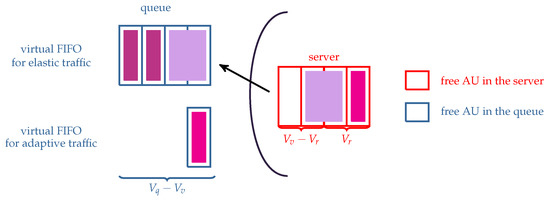
Figure 4.
Queuing system with virtual FIFO queues.
3.3.2. vFIFOs
The second scenario explored to utilise the virtual queues mechanism involves a system in which the number of virtual queues corresponds to the number of call classes offered to the system. Similar to the previous case, the queues are selected using the round-robin algorithm. However, there is a difference in service discipline: if a call from the selected queue cannot be served or the queue is empty, the next queue in line is checked. This approach helps minimise the limitations of the FIFO discipline and ensures better usage of server resources compared to vFIFO. Figure 5 illustrates the implementation of the vFIFOs queue for the considered system.

Figure 5.
Queuing system with virtual FIFO queues for each class offered to the system with the overtaking calls process.
3.4. vcFIFO
The cFIFO queue discipline considers only the scenario with two virtual queues, one for each traffic type. This approach arises from the principle that calls will be transferred, even partially, from the queue to the server whenever there is at least one available AU in the server. It is assumed that the selection of the queue from which the call (or a portion of it) will be taken is proportional to the number of calls awaiting service in the virtual queues. In other words, the higher the number of calls in a particular virtual queue, the greater the likelihood of its selection. Figure 6 provides an example of a system with a service discipline defined in this manner.
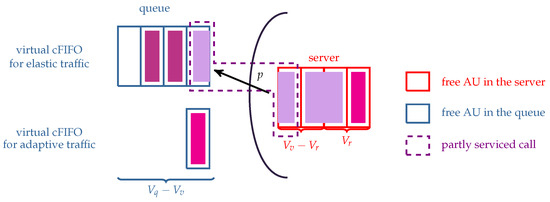
Figure 6.
Queuing system with virtual vcFIFO discipline.
4. Numerical Results
To conduct the research outlined in this article, it was imperative to develop and implement a simulator for a multi-service queuing system capable of servicing a combination of elastic and adaptive traffic. The simulator incorporates various queue disciplines, including FIFOs, vFIFOs, vFIFOs, and cvFIFOs, as discussed in the corresponding chapter. The implementation of the simulator was carried out in C++ following the event scheduling method [35,36]. The results presented in this paper were obtained from six queuing systems, each characterised by the parameters specified in Table 2.

Table 2.
The parameters of queuing systems.
Similar to the simulation programme, the analytical model was implemented in C++. In both cases, the obtained results were saved in text files. From the results obtained (calculations and simulations), the relative error was determined according to the formula:
where:
- represents the determined relative error value for the parameter X, such as the class 1 blocking probability;
- signifies the value of parameter X obtained from the simulation experiment;
- signifies the value of parameter X obtained from calculation.
Based on the results, charts were prepared using the gnuplot environment [37].
It was assumed that the same mixture of traffic was offered to all considered systems (–). This mixture consisting of one class of elastic traffic demanded two AUs () for service, and two classes of adaptive traffic requesting one and three AUs (, ), respectively. For each system, an evaluation was carried out to ascertain the accuracy of the proposed analytical model by comparing it against simulation results obtained by utilising each of the proposed queuing disciplines. Specifically, a comprehensive analysis was conducted to assess the blocking probabilities associated with each traffic class offered to the system, as well as to evaluate the total queue length. This assessment encompassed three distinct levels of offered traffic per single AU: 0.7, 1.0, and 1.3 Erl. The relationship between the traffic offered per single AU (a) and the traffic offered by each call class is as follows:
Figure 7, Figure 8, Figure 9, Figure 10, Figure 11 and Figure 12 depict the results concerning the blocking probability for the different classes offered to the – systems. Upon analysing the presented outcomes, it can be inferred that cFIFO or vcFIFO disciplines in the simulator yield the lowest error values. This can be attributed to the similarity between these two disciplines and the SDFIFO discipline. The latter assumes the possibility of partial call service and allows for resource allocation in fractions of the specified allocation unit for the system in question (cFIFO and vcFIFO assume call splitting withe an accuracy of up to 1 AU). The maximum error for the vcFIFO discipline does not exceed 10%, whereas for cFIFO, it remains within 15%. However, the results presented here demonstrate instances in which the cFIFO and vcFIFO disciplines do not guarantee the lowest error state. Notably, the vFIFOs discipline for the class demanding one AU achieves the minimum error values, as is evident from the graphs (Figure 7 and Figure 10). This phenomenon can be attributed to the vFIFOs discipline’s capability to create virtual queues for each class of calls, regardless of the traffic type. Moreover, if a call cannot be moved from the currently selected virtual queue to the server, the remaining queues are examined, prioritising calls from the class with the lowest system capacity unit requirement at the expense of other classes. This behaviour is observable in the case of the class demanding three AUs (Figure 9 and Figure 12), where the disciplines shows the highest relative error values.
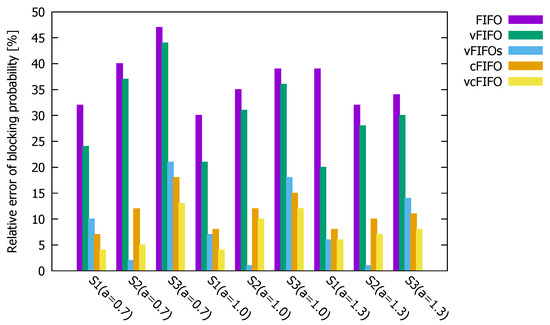
Figure 7.
Relative error of blocking probability of the class 1 call S1–S3.
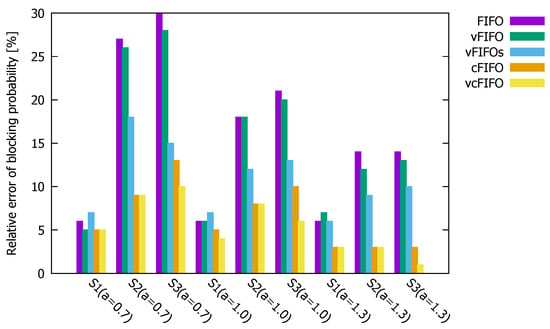
Figure 8.
Relative error of blocking probability of the class 2 call S1–S3.
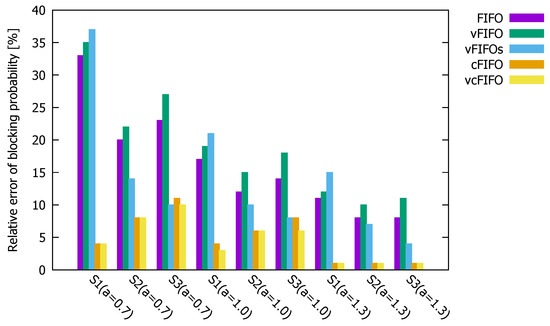
Figure 9.
Relative error of blocking probability of the class 3 call S1–S3.
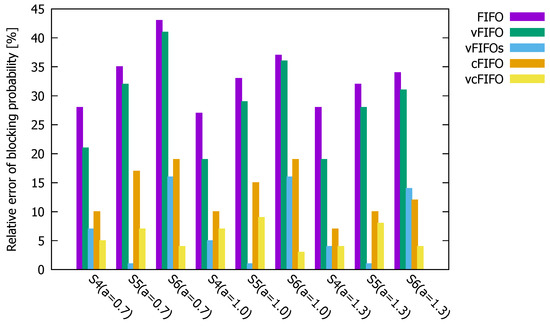
Figure 10.
Relative error of blocking probability of the class 1 call S4–S6.
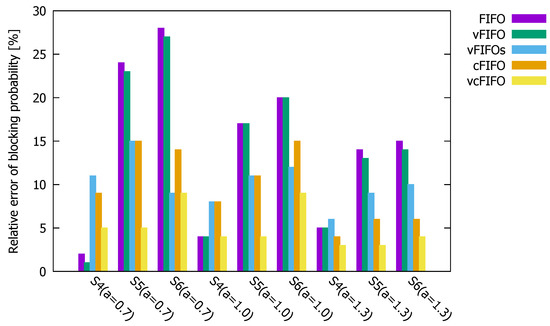
Figure 11.
Relative error of blocking probability of the class 2 call S4–S6.
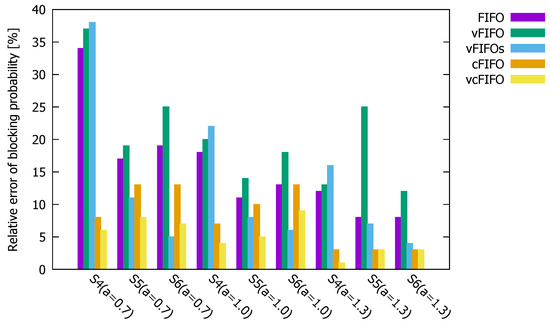
Figure 12.
Relative error of blocking probability of the class 3 call S4–S6.
The second scenario in which the cFIFO and vcFIFO disciplines yield inferior outcomes compared to the others occurs within – systems for Class 2. Interestingly, in this case, the FIFO and vFIFO disciplines show the lowest error rates. This scenario is particularly intriguing because it cannot be directly attributed to the characteristics of the service disciplines. It is likely that the performance of this specific queuing system is influenced by the combinatorial properties of the class requesting two AUs of the system, especially when dealing with small levels of offered traffic.
In terms of total queue length, the cFIFO and vcFIFO disciplines show the lowest error value, with values not exceeding 10% (Figure 13 and Figure 14). Similar to the blocking probability scenario, this can be attributed to the substantial resemblance of these disciplines to the SDFIFO discipline.
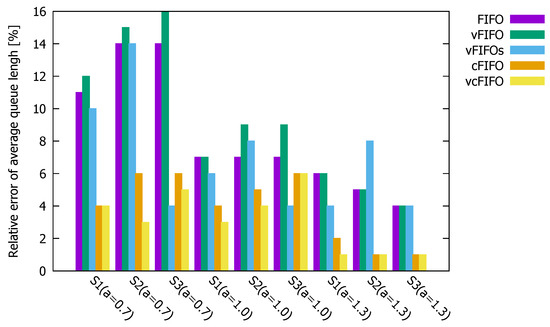
Figure 13.
Relative error of average queue length for systems S1–S3.
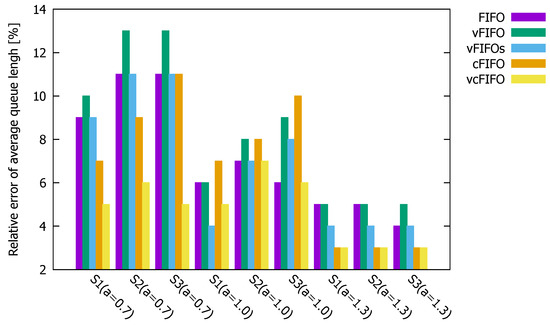
Figure 14.
Relative error of average queue length for systems S4–S6.
The SDFIFO queue model with compression provides a more accurate approximation for systems in which server utilisation remains independent of the offered traffic calls. Notably, this applies to disciplines such as cFIFO and vcFIFO, as demonstrated in the presented examples. In contrast, the FIFO discipline exhibits the least favourable characteristics, allowing for simultaneous occurrences of the both idle server resources and busy queue resources. Regardless of the adopted queue discipline, as the offered traffic increases, the analytical model provides a more accurate approximation of the considered systems with real queue disciplines.
It is noteworthy that, considering a maximum acceptable approximation error of 30% from an engineering standpoint, the SDFIFO model can successfully represent queuing systems featuring all the presented service disciplines. In order to minimise the approximation error, further research can be conducted to explore the intricate relationship between the error and the system’s structure. Based on these findings, viable corrective measures can be formulated and proposed.
5. Summary
The rapidly expanding ICT services market generates vast volumes of data. Modern ICT systems possess ever-increasing data transfer capabilities, leading many users to perceive these systems as virtually unlimited in resources. However, the 2020–2022 pandemic years have revealed the inherent limitations of ICT systems. Consequently, it has become imperative to optimise the utilisation of available resources. The optimisation process relies heavily on appropriate tools, such as analytical models. One such model is the SDFIFO model. Despite the theoretical nature of the SDFIFO discipline itself, given the complex and time-consuming nature of queue service process, the analytical model itself remains simple and can be effectively represent systems employing other queuing disciplines, including those utilising the cFIFO disciplines. Although a specific analytical model exists for the cFIFO discipline, its implementation is complex due to the employment of the convolution method for distribution determination.
Author Contributions
Conceptualisation, S.H. and J.W.; Methodology, J.W.; Software, S.H. and J.W.; Validation, S.H.; Formal analysis, S.H. and J.W.; Investigation, S.H. and J.W.; Writing—original draft, S.H. and J.W.; Supervision, J.W. All authors have read and agreed to the published version of the manuscript.
Funding
This research is funded by the Polish Ministry of Education and Science, Grant 0313/SBAD/1310.
Data Availability Statement
Data integral to this study may be obtained by contacting the corresponding author, who will ensure accessibility upon a duly justified request.
Conflicts of Interest
The authors declare no conflict of interest.
References
- Ericsson. Ericsson Mobility Report; Technical Report; Ericsson: Stockholm, Sweden, 2021. [Google Scholar]
- Cisco. Cisco Annual Internet Report (2018–2023); Technical Report; Cisco: San Jose, CA, USA, 2020. [Google Scholar]
- Roberts, J. Teletraffic Models for the Telecom 1 Integrated Service Network. 1983, pp. 1–7. Available online: https://cir.nii.ac.jp/crid/1573387449275230208 (accessed on 9 July 2023).
- Tran-Gia, P.; Hübner, F. An Analysis of Trunk Reservation and Grade of Service Balancing Mechanisms in Multiservice Broadband Networks. In Modelling and Performance Evaluation of ATM Technology, Proceedings of the IFIP TC6 Task Group/WG6.4 International Workshop on Performance of Communication Systems, Martinique, French Caribbean Island, 25–27 January 1993; Perros, H.G., Pujolle, G., Takahashi, Y., Eds.; North-Holland Publishing Co.: Amsterdam, The Netherlands, 1993; Volume C-15, pp. 83–97. [Google Scholar]
- Stasiak, M.; Głąbowski, M. A simple approximation of the link model with reservation by a one-dimensional Markov chain. Perform. Eval. 2000, 41, 195–208. [Google Scholar]
- Stasiak, M.; Hanczewski, S. Approximation for Multi-Service Systems with Reservation by Systems with Limited-Availability. In Proceedings of the 5th European Performance Engineering Workshop on Computer Performance Engineering, Berlin/Heidelberg, Germany, 24–25 September 2008; EPEW ’08. pp. 257–267. [Google Scholar] [CrossRef]
- Abeni, L.; Palopoli, L.; Scordino, C.; Lipari, G. Resource Reservations for General Purpose Applications. IEEE Trans. Ind. Informatics 2009, 5, 12–21. [Google Scholar] [CrossRef]
- Moscholios, I.; Vardakas, J.; Logothetis, M.; Boucouvalas, A. Congestion probabilities in a batched Poisson multirate loss model supporting elastic and adaptive traffic. Ann. Telecommun. 2013, 68, 327–344. [Google Scholar] [CrossRef]
- Hanczewski, S.; Stasiak, M.; Weissenberg, J. Queueing model of a multi-service system with elastic and adaptive traffic. Comput. Networks 2018, 147, 146–161. [Google Scholar] [CrossRef]
- Kaufman, J. Blocking with retrials in a completely shared resource environment. Perform. Eval. 1992, 15, 99–116. [Google Scholar] [CrossRef]
- Rácz, S.; Gerö, B.P.; Fodor, G. Flow Level Performance Analysis of a Multi-Service System Supporting Elastic and Adaptive Services. Perform. Eval. 2002, 49, 451–469. [Google Scholar] [CrossRef]
- Sobieraj, M.; Stasiak, M.; Weissenberg, J.; Zwierzykowski, P. Analytical Model of the Single Threshold Mechanism with Hysteresis for Multi-Service Networks. IEICE Trans. Commun. 2012, 95-B, 120–132. [Google Scholar] [CrossRef]
- Moscholios, I.D.; Logothetis, M.D.; Kokkinakis, G.K. Connection-dependent threshold model: A generalization of the Erlang multiple rate loss model. Perform. Eval. 2002, 48, 177–200. [Google Scholar] [CrossRef]
- Bonald, T.; Virtamo, J. A recursive formula for multirate systems with elastic traffic. IEEE Commun. Lett. 2005, 9, 753–755. [Google Scholar] [CrossRef]
- Hanczewski, S.; Stasiak, M.; Weissenberg, J. A Model of a System With Stream and Elastic Traffic. IEEE Access 2021, 9, 7789–7796. [Google Scholar] [CrossRef]
- Hanczewski, S.; Stasiak, M.; Weissenberg, J. A Queueing Model of a Multi-Service System with State-Dependent Distribution of Resources for Each Class of Calls. IEICE Trans. Commun. 2014, E97-B, 1592–1605. [Google Scholar] [CrossRef]
- Hanczewski, S.; Stasiak, M.; Weissenberg, J. The Model of the Queuing System with Adaptive Traffic. In Proceedings of the 2017 IEEE 19th International Conference on High Performance Computing and Communications; IEEE 15th International Conference on Smart City; IEEE 3rd International Conference on Data Science and Systems (HPCC/SmartCity/DSS), Bangkok, Thailand, 18–20 December 2017; pp. 303–308. [Google Scholar] [CrossRef]
- Weissenberg, J.; Weissenberg, M. Model of a Queuing System With BPP Elastic and Adaptive Traffic. IEEE Access 2022, 10, 130771–130783. [Google Scholar] [CrossRef]
- Głąbowski, M.; Kmiecik, D.; Stasiak, M. Modelling Overflow Systems with Queuing in Primary Resources. In Quality, Reliability, Security and Robustness in Heterogeneous Systems; Duong, T.Q., Vo, N.S., Phan, V.C., Eds.; Springer International Publishing: Cham, Switzerland, 2019; pp. 148–157. [Google Scholar]
- Hanczewski, S.; Stasiak, M.; Zwierzykowski, P. Modelling of the access part of a multi-service mobile network with service priorities. EURASIP J. Wirel. Commun. Netw. 2015, 2015, 194. [Google Scholar] [CrossRef]
- Chydzinski, A. Queues With the Dropping Function and Non-Poisson Arrivals. IEEE Access 2020, 8, 39819–39829. [Google Scholar] [CrossRef]
- Patel, S. Performance analysis of RED for stabilized queue. In Proceedings of the 2014 Seventh International Conference on Contemporary Computing (IC3), Noida, India, 7–9 August 2014; pp. 306–311. [Google Scholar] [CrossRef]
- Kelly, F.P. Notes on Effective Bandwidth; Technical Report; University of Cambridge: Cambridge, UK, 1996. [Google Scholar]
- Roberts, J.W.; Mocci, V.; Virtamo, I. (Eds.) Broadband Network Teletraffic, Final Report of Action COST 242; Commission of the European Communities; Springer: Berlin/Heidelberg, Germany, 1996. [Google Scholar]
- Hanczewski, S.; Stasiak, M.; Weissenberg, J. The Queueing Model of a Multiservice System with Dynamic Resource Sharing for Each Class of Calls. In Computer Networks; Kwiecień, A., Gaj, P., Stera, P., Eds.; Communications in Computer and Information Science; Springer: Berlin/Heidelberg, Germany, 2013; Volume 370, pp. 436–445. [Google Scholar]
- Kendall, D.G. Stochastic Processes Occurring in the Theory of Queues and their Analysis by the Method of the Imbedded Markov Chain. Ann. Math. Stat. 1953, 24, 338–354. [Google Scholar] [CrossRef]
- Shortle, J.F.; Thompson, J.M.; Gross, D.; Harris, C.M. Fundamentals of Queueing Theory; John Wiley & Sons, Inc.: Hoboken, NJ, USA, 2018. [Google Scholar]
- Stamatelos, G.M.; Koukoulidis, V.N. Reservation-based Bandwidth Allocation in a Radio ATM Network. IEEE/ACM Trans. Netw. 1997, 5, 420–428. [Google Scholar] [CrossRef]
- Postel, J. Transmission Control Protocol; Tech. rep. rfc 793 (INTERNET STANDARD); Internet Engineering Task Force: Fremont, CA, USA, 1981. [Google Scholar]
- Schulzrinne, H.; Casner, S.; Frederick, R.; Jacobson, V. RTP: A Transport Protocol for Real-Time Applications; Tech. rep. rfc3550 (INTERNET STANDARD); Internet Engineering Task Force: Fremont, CA, USA, 2003. [Google Scholar]
- Lindberger, K. Balancing Quality of Service, Pricing and Utilisation in Multiservice Networks with Stream and Elastic Traffic. Proc. ITC 16 1999, 1127–1136. [Google Scholar]
- Brockmeyer, E.; Halstrom, H.; Jensen, A. The Life and Works of A.K. Erlang; The Copenhagen Telephone Company: Copenhagen, Denmark, 1948. [Google Scholar]
- Hanczewski, S.; Kaliszan, A.; Stasiak, M. Convolution Model of a Queueing System with the cFIFO Service Discipline. Mob. Inf. Syst. 2016, 2016, e2185714. [Google Scholar] [CrossRef]
- Dey, N.S.; Gunasekhar, T. A Comprehensive Survey of Load Balancing Strategies Using Queue Scheduling and Virtual Machine Migration. IEEE Access 2019, 7, 92259–92284. [Google Scholar] [CrossRef]
- Tyszer, J. Object-Oriented Computer Simulation of Discrete-Event Systems; Springer: New York, NY, USA, 2012. [Google Scholar]
- Hanczewski, S.; Weissenberg, J. The Impact of the Adopted Queue Discipline on the Accuracy of the Analytical Model in Queuing Systems with Elastic and Adaptive Traffic. In Proceedings of the 2022 International Conference on Broadband Communications for Next Generation Networks and Multimedia Applications (CoBCom), Graz, Austria, 12–14 July 2022; pp. 1–7. [Google Scholar] [CrossRef]
- Gnuplot Homepage. Available online: http://www.gnuplot.info/ (accessed on 20 July 2023).
Disclaimer/Publisher’s Note: The statements, opinions and data contained in all publications are solely those of the individual author(s) and contributor(s) and not of MDPI and/or the editor(s). MDPI and/or the editor(s) disclaim responsibility for any injury to people or property resulting from any ideas, methods, instructions or products referred to in the content. |
© 2023 by the authors. Licensee MDPI, Basel, Switzerland. This article is an open access article distributed under the terms and conditions of the Creative Commons Attribution (CC BY) license (https://creativecommons.org/licenses/by/4.0/).